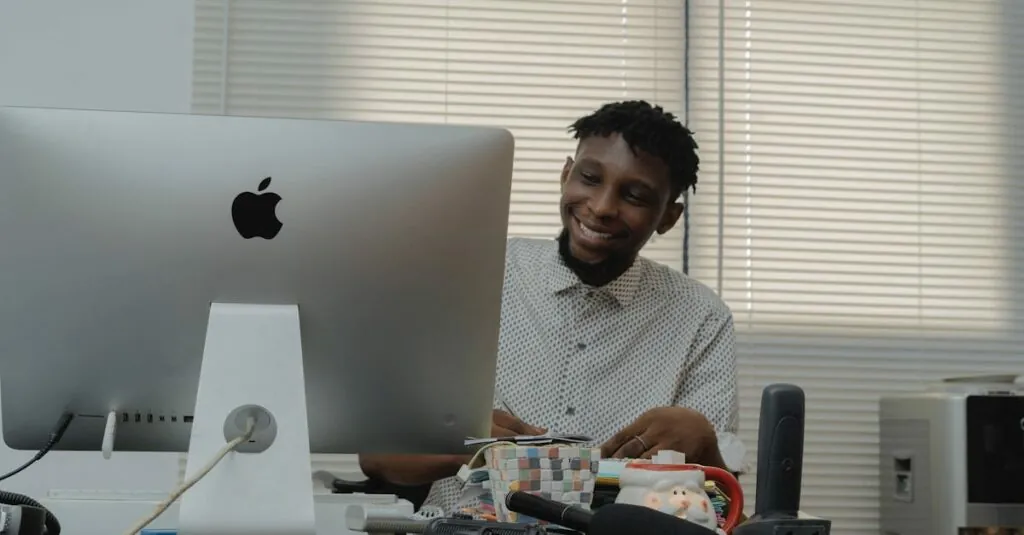In the world of 3D printing, a great slicer is like a master chef in a kitchen full of ingredients. It transforms raw digital designs into delectable layers of plastic goodness. Without the right slicer, even the most brilliant 3D models can end up looking like a pancake that fell off the plate.
Choosing the best 3D printer slicer can feel overwhelming, but it doesn’t have to be. With the right tools, anyone can turn their wildest ideas into reality—without the mess of a culinary disaster. From user-friendly interfaces to advanced features, the best slicers are designed to make printing a breeze. So buckle up, because it’s time to slice through the confusion and find the perfect fit for your 3D printing adventures.
Table of Contents
ToggleOverview of 3D Printer Slicers
3D printer slicers serve a crucial role in converting 3D models into printable instructions. These software tools break down complex designs into layers that the printer can understand and execute. Each slicer offers unique features that cater to various user needs, influencing print quality and speed.
One primary factor in choosing a slicer lies in its user interface. Intuitive interfaces simplify the printing process, allowing users to focus on creativity rather than technical hurdles. Additionally, advanced features such as adaptive slicing and support generation enhance print success rates, particularly for intricate designs.
Compatibility also matters when selecting a slicer. Many slicers support a wide range of 3D printers, providing flexibility for users who may upgrade their equipment. Open-source options, like Cura and PrusaSlicer, allow for community-driven improvements, ensuring continuous enhancements based on user feedback.
Print settings form another critical aspect. Slicers allow adjustments in layer height, fill density, and print speed, affecting the overall performance and outcome of prints. Knowledge of these settings enables users to optimize their prints for strength, accuracy, or speed based on specific project requirements.
The availability of material profiles further streamlines the printing process. Pre-configured settings for popular filaments like PLA, ABS, and PETG simplify the user experience, reducing the need for manual adjustments. By leveraging these profiles, users can achieve consistent results across different prints.
Investing time in understanding various slicers provides valuable insights. Familiarity with individual slicer’s strengths and weaknesses leads to informed decisions, ultimately enhancing 3D printing outcomes.
Key Features to Consider
Various features determine the best 3D printer slicers. Understanding these elements ensures efficient and effective printing.
Compatibility with Printers
Compatibility with printers varies significantly across slicers. Users should prioritize slicers that support their specific printer models. Many slicers, like Cura and PrusaSlicer, offer extensive printer compatibility, ensuring flexibility. A wide range of supported machines increases a user’s options, facilitating diverse projects. Checking manufacturer recommendations guarantees optimal performance.
User Interface and Experience
User interface and experience play critical roles in slicer selection. Intuitive designs make it easier for users to navigate settings and create prints. The layout should provide quick access to key features, minimizing frustration. Slicers that offer customizable interfaces allow users to tailor their experiences to fit personal preferences. An efficient interface also enhances productivity, promoting smoother workflows.
Slice Speed and Quality
Slice speed and quality significantly impact print outcomes. Faster slicing times reduce overall project duration without sacrificing detail. Maintaining high quality is paramount, especially for intricate designs. Users often look for slicers that balance speed and output quality effectively. Accurate slicing leads to better adhesion and fewer print failures, contributing to successful projects. Finding a slicer that achieves this balance can optimize the 3D printing experience.
Top 3D Printer Slicers
Choosing the right slicer greatly impacts the success of 3D printing projects. Below are three popular slicers known for their unique features.
Slicer A: Overview and Features
Slicer A offers a user-friendly interface that simplifies navigation for beginners and experts alike. It supports a wide range of file formats, enabling compatibility with numerous 3D printers. Adaptive slicing enhances printing accuracy, particularly for complex models. Users appreciate its customizable settings that allow fine-tuning of layer height, fill density, and speed. Material profiles for popular filaments streamline setup, ensuring consistent outcomes for a variety of projects. Regular updates contribute to overall performance improvements, making Slicer A a reliable choice.
Slicer B: Overview and Features
Slicer B stands out with its innovative support generation features, which significantly reduce print failures. This slicer excels in generating complex geometries while maintaining high print quality. Users frequently highlight its advanced preview options, providing a clear view of print paths before starting. Compatibility extends to numerous printer models, ensuring versatility for different setups. Users can adjust print settings with precision, promoting efficiency across different projects. Additionally, an active user community offers valuable resources and constant enhancements.
Slicer C: Overview and Features
Slicer C is celebrated for its powerful customizability, allowing detailed adjustments to nearly every parameter. An intuitive interface complements its advanced features, making it accessible for users at all skill levels. Layer segmentation options help optimize printing time without sacrificing quality. Its built-in material profiles cater to various filaments, making setup straightforward. Users often benefit from practical plugins that extend functionality for specific printing needs. Continuous community support enhances development, making Slicer C a well-rounded option for serious 3D printing enthusiasts.
Performance Comparison
Performance comparison between different slicers reveals significant differences in print quality and speed. Users must consider these aspects for optimal 3D printing results.
Print Quality Analysis
Print quality varies among slicers based on resolution and layer management. Slicer A excels in producing smooth surfaces due to its advanced adaptive slicing algorithm, reducing visible layer lines. Slicer B offers exceptional support structures that prevent problems like sagging or warping in complex designs. Slicer C stands out for customizability, enabling tailored adjustments to printing parameters, leading to remarkable detail and finish. Each slicer provides unique qualities that enhance overall print performance, demonstrating the importance of selecting the right tool for specific printing projects.
Speed and Efficiency
Speed and efficiency significantly impact project turnaround times. Slicer A processes designs quickly without compromising quality, making it suitable for larger prints. Slicer B optimizes print time through innovative support mechanisms, avoiding lengthy adjustments during each print session. Slicer C, known for customization options, allows users to fine-tune settings to balance speed with desired outcomes. Evaluating these elements helps users maximize their efficiency and effectiveness in the 3D printing process, enabling the realization of creative ideas.
Selecting the right 3D printer slicer is vital for achieving outstanding print results. Each slicer discussed offers unique features that cater to different user needs and preferences. By understanding the strengths of Slicer A, Slicer B, and Slicer C, users can make informed choices that enhance their 3D printing experience.
Investing time in exploring these tools not only streamlines the printing process but also fosters creativity. With the right slicer in hand, users can confidently bring their innovative designs to life, ensuring high-quality prints that meet their expectations. Embracing the right technology is key to unlocking the full potential of 3D printing.





